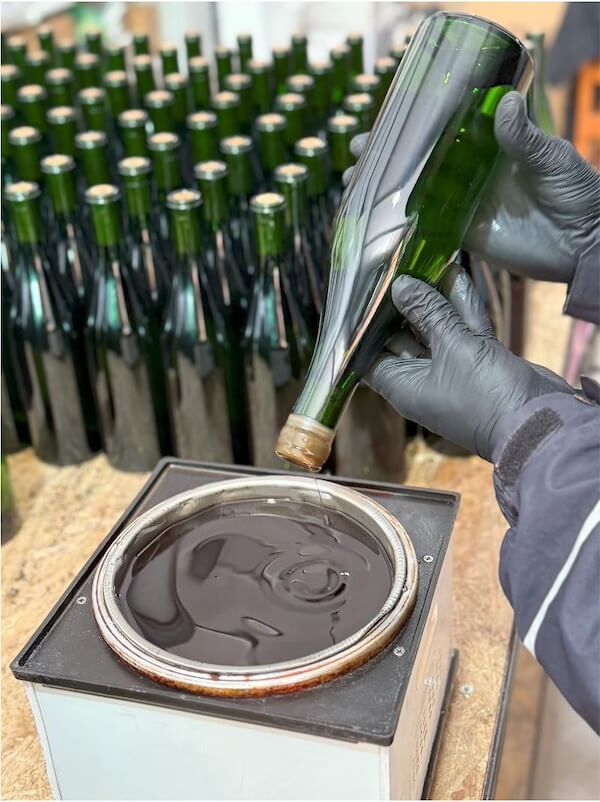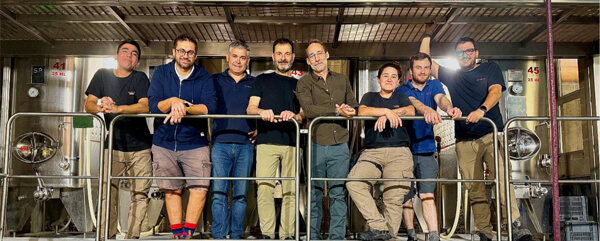We were lucky enough to welcome Piero Incisa Della Rochetta to London last week, for three days of tasting, touring and discussion, to welcome the 2024 vintage.
If you are still unfamiliar with this project, Bodega Chacra is run by Piero, who is the grandson of the inventor of Sassicaia and his business partner Jean-Marc Roulot, who makes some of the finest wine in Meursault (you can easily part with £1,000 for just one bottle).

The Chacra Story
These two towering figures have bought their expertise to remote Patagonia, establishing not just a world class viticultural project, but a self-sustaining organism in the middle of a desert. Piero, who was intent on making Pinot Noir, was set on coastal California, before stumbling across a bottle of Patagonian Pinot Noir at a tasting in New York.
It was a region, due to its cool climate, where Pinot & Chardonnay were originally cultivated for their high quality – especially to use in sparkling wine, until tax incentives made a lot of interests up and leave for Mendoza.
Having tasted this bottle, which Piero admits in itself was not exceptional, but conveyed something raw, exciting and potential about the terroir, he took off to visit his cousin in the region (I am led to believe if you are part of an Italian wine dynasty, these cousins are easy to come by).
With some direction from her, he was introduced to a government official, whose job it was to keep tabs on all the vine plantings across Patagonia. Piero was presented with a stack of A3 cards, each containing some detail about the age of the vines, the location, soil, climate… It was a few day’s work just to assimilate and process these, before he set out touring the landscape.
One of the mains issues was just how abandoned the idea of Pinot Noir in this region had become. After the potential sparkling wine boom, then bust, most had decided to pull up their vines and swap them for Malbec – so there were a lot of false starts.
Eventually, though, he found what he was looking for.
A long neglected, overgrown patch of Pinot Noir vines, first planted in 1932, in the Rio Negro. Piero asked the farmer is he could buy this little 1.6 hectare plot, and was told no – he would just waste his money, and two years later, go home with his tail between his legs.
Determined, they came to a rental agreement – in the beating sun, under a fig tree, a handshake deal was made, as 15 or so of the farmers tiny dogs nipped at their ankles, to allow Piero two years to reform the vineyard and harvest its fruit, which he vinified in his cousin’s winery.

What a difference 20 years makes – the purposeful revitalisation of old vines at Chacra.
That was 20 years ago, and this plot now makes up the winery’s flagship (and desperately rare) ‘32’ cuvee, made solely from this small plot of ancient vines. Over these 20 years, Piero hasn’t just succeeded in making world class Pinot Noir (his cuvees occupy an unprecedented 8 of the top 10 scores for Argentinian Pinot Noir on Robertparker.com) but he has built a self-sustaining community in the desert.
 As well as wine, Chacra crops 1.5 hectares of wheat, has a herd of goats, and an enormous biodynamic & organic vegetable garden – all of which help nourish the team which bring the wine to life. The attention to detail here is such that the beehives that dot the estate, alongside helping with vine pollination, also produce the wax for the bottle capsules.
As well as wine, Chacra crops 1.5 hectares of wheat, has a herd of goats, and an enormous biodynamic & organic vegetable garden – all of which help nourish the team which bring the wine to life. The attention to detail here is such that the beehives that dot the estate, alongside helping with vine pollination, also produce the wax for the bottle capsules.
This original vineyard, the ‘32’, was augmented by a second, the ‘55’ – 7 hectares of vines originally planted in 1955 and in 2017 Chacra made its first white wine.
Piero tells the story that, he had a plot in mind (40 year old Merlot vines, just outside the now fully established winery) for white – specifically, to graft Chardonnay, as it ran over an ancient alluvial river bed. These calcium carbonate covered, granitic rocks, which he describes rather elegantly as ‘the vomit of the Andes’ are Argentina’s white wine soil. He had been in discussion with some wine makers in Chablis, when, over dinner with his friend Jean-Marc Roulot, he relayed the idea. ‘Don’t get some guys in Chablis to do it, choose me’, or words to that effect, was Jean-Marc’s response.
Piero, of his own admission, was dumbstruck. He describes it as like ‘asking the pope to come and conduct mass in a tiny Sussex village Church’, and so made his excuses, before flying back to Patagonia. It was some months later, on a call with his geologist (the legendary Pedro Parra, who literally has a Phd in terroir and works with the likes of Lafite, Commando G and Biondi Santi) when he mentioned it and was roundly told off – the order was to call Jean-Marc, so he did, and Roulot joined the project, not as a consultant, but a full business partner.

Piero (centre right) and Jean-Marc (centre left) surrounded by their team at the winery.
The 2024 vintage
This year, we are very pleased to be releasing their 2024s, a vintage which the press have already begun comparing with the outstanding 2021 season. Despite this objective praise, the vintage was not plain sailing – a seasonal wind, called the Zonda (we promise this isn’t a knock off car) buffeted the grapes and the weather grew so hot in January that the vines shut down.
The result of this curious combination was thick skins, so a danger of over-extraction for the reds, and a period where the vines were not photosynthesising, so the alcohols are low. What is in the glass is testament to the skill of these two exceptional wine makers, and the whole team at Chacra.
The wines have depth and intensity, while remaining incredibly fresh, elegant and light on their feet.
Over the last month, I have been lucky enough to drink the 2024, 23, 22, 2018 and 2012 of Piero’s ’55’ Pinot Noir, as well as the 2024, 23, 22 and 2019 of Jean Marc’s Chardonnay. To the former, I can attest that this is wine you will enjoy from day one to year 10 and beyond. The 2012 was spellbinding and felt fresher than many a Grand Cru Burgundy.
My greatest revelation with the Chardonnay came in two forms, firstly that the 2019 is in an amazing spot, but felt like it could age for another decade, but the second and most meaningful, was over dinner, with a friend kind enough to bring a bottle of Roulot’s 2022 Meursault. To have this alongside the 2022 Chacra Chardonnay was my personal proof in the assertion that Jean-Marc made when we first met him, that ‘Chacra Chardonnay is the qualitative equal of my Meursault village’.

A few shots from last week’s masterclass.
If I hadn’t managed to evidence it in my above ramblings, let me just make it clear how much of a fan I am of these wines. I could wax lyrical about them for days… but I won’t. Just try them and let them speak for themselves. Drinking a Bodega Chacra is an incredible experience that you owe it to yourself to be part of.